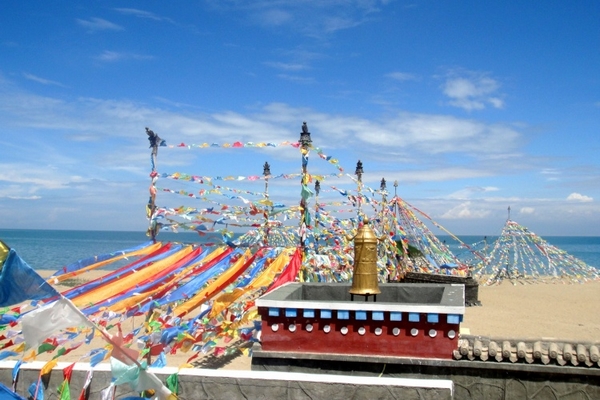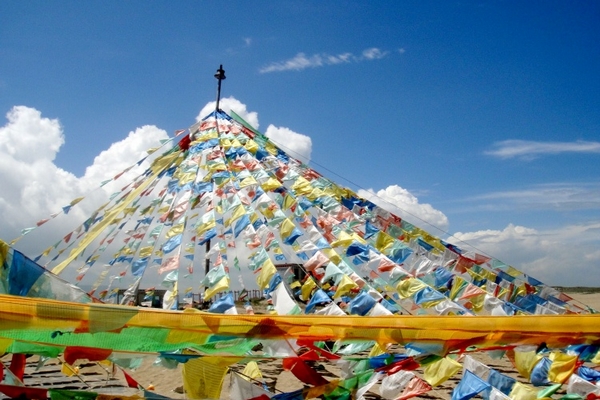Mysterious Tibetan land: colorful prayer flag culture

There are different arguments with regards the origin of prayer flags. One is from ancient India where the women normally wore sari skirts. Whenever the husband went out on an expedition it was customary to tear a piece of clothing off and hang it on the door or a tree to see him off. Following the rise of Buddhism, this sari gradually evolved into a piece of gauze with a Buddha statue and the scriptures printed on up until the prayer flags of today.
Tibetan scholar Gedun Chophel believes that during the Tubo military empire military families had to stand their spear to display glory, which was a custom for military remembrance among Tibetan people. During the period of Tibetan King Songtsen Gampo, in order to ensure centralized management throughout the whole Tubo area, the territory was divided into “Five Ru” (five wings). Five military and political regions were set up across the whole country, namely: Wuru (Lhasa region today), Yueru (Nedong Qamdo), Yeru (Namling), Rula (Lhatse) and subsidiary Su Pilu.

There are many kinds of prayer flags but according to color they can broadly be divided into two categories: one kind uses black or vermilion to print the scripture icons on white cloth; the other kind is similar to “wind horse flags” in that the scripture icons are alternatively assembled on blue, white, yellow, red and green cloth. The form in which the prayer flags are assembled is based on the different scenes, beliefs and rituals, and prayer function, but are generally divided into four categories.
The first is the hanging type, which is used for decoration and depends on the environment and terrain. There are long and short ones as well as thin and thick ones. The long ones stretch to several hundred meters and the thick ones are made up of several hundred layers. Some are combined into large-scale prayer flag cities, covering an area of several thousand square meters. There is a variety of different specific shapes. Some have a square wind horse flag pattern printed on a long strip of cloth; others are meshed flags.
The second type is the inserted hanging type, which has the wind horse flag pattern printed on a vertical rectangular gauze or scarf. One side is sewn to the flagpole, while on the other side X there are many straight ribbons. These wind horse flags are mainly placed at village entrances, on roofs, at crossroads, on mountain path or at the top of mountains.

The third type is a prayer flag tower, which uses different colors of cloth or Hada scarves. In Kangding, Dawu and other counties every village has an umbrella-like prayer flag tower with hanging layers of prayers flags made from silk and overlapping pieces. It is used as a place for offering collective sacrifice. In Matod County at the source of the Yellow River there is a prayer flag tower more than ten meters high and more than 100 meters in radius. It uses lots of Yak rope tied together in a radial pattern and is made up of dozens of layers of prayer flags circled around the center and piled high into a tall prayer flag column. The whole structure appears like a spacious pyramid – it really is a spectacular sight.
The fourth type is an upright column and is often seen in monasteries, Buddhist temples, towers, houses, holy lakes on mountain tops and holy mountains. The larger shaped ones can reach tens of meters high, like the prayer flag column at the foot of Ngari’s Holy Mount Kailas or the one in front of the “lucky tower” at Gyantse’s Palkhor Chode Monastery. The top of the column is decorated with a copper gold-plated sun and moon, Aquarius, a colorful canopy and yak tail. The long wind horse prayer flags make a swooshing noise in the wind.
The prayer flags we usually see are long and short, with various different patterns. The longest is between three to five meters and 60cm thick with animal and bird patterns and the scriptures printed on them. They are red or white and are usually found hanging from prayer flag poles in squares and in front of monasteries. The short prayer flags are usually blue, white, red, green or yellow and square-shaped with animal and bird patterns and the scriptures printed on them. They are often found on long ropes hanging on sparsely populated mountain passes. Prayer flags with no words are usually found hanging on roofs and are made up of blue, white, red, green and yellow stripes, with the main flag embroidered with black and white.
The five colors symbolize the five phenomena of the natural world and this is the material basis for the existence of life. Blue is believed to symbolize the sky; white the clouds; red the flame; and yellow the land. As a result, the prayer flag order from top to bottom is fixed. Just like the blue sky being above and yellow ground below in nature is unchangeable, the colored order of prayer flags also can’t change.
In addition, the most widely seen wordless flag has a main flag embroidered into it. The main flag has the same five colors as other prayer flags, as does the embroidery, but the main flag must be of a different color. This type of wordless flag is often hung from the roofs of people’s houses and is in fact a special symbol for living in that particular house. The color of the main flag represents the birthday of the most respected elders in the family.
Your Comment
Name E-mailRelated News
-
;
-
-

-
Prayer flag changing ceremony held during Losar
Photo shows the local residents throwing zanba (roasted highland barley flour) at the prayer flag changing ceremony in Taktse Village.
-
-
-

-
Prayer flag changing ceremony held during Losar
As one of the annual traditions of celebrating the Tibetan New Year (Losar), new prayer flags have been exchanged for the old ones that faded in the past year, in order to pray for good harvest, good luck and happiness.
-
-
-

-
Colorful prayer flag trees boost festival atmosphere in Lhasa
As the most ceremonious festival in Tibet approaches- the Tibetan New Year, or Losar- Tibetan residents begin to prepare for the festival by making colorful prayer flag trees, a custom reflecting their good wishes for the New Year.
-
Based in Lhasa, Tibet Vista is a Tibet travel agency that specialized in Tibet permit, and Tibet tours for both private and group travelers at a local price!
•4 Days Lhasa City Group Tour from USD 460 •8 Days Everest Base Camp Group Tour from USD 850 •15 Days Mt.Kailash Group Tour from USD 1780 •2016 Tibet Train Tours from Beijing, Shanghai, Chengdu, Xining,etc










